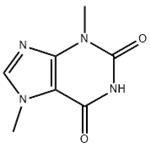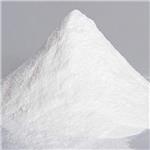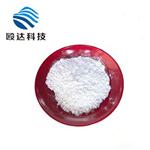- Theobromine
-

- $8.00 / 1kg
-
2024-04-24
- CAS:83-67-0
- Min. Order: 1kg
- Purity: 99%
- Supply Ability: g-kg-tons, free sample is available
- Theobromine
-

- $0.00 / 1kg
-
2024-04-02
- CAS:83-67-0
- Min. Order: 1kg
- Purity: 99%
- Supply Ability: 100ton
- Theobromine
-

- $0.00 / 1kg
-
2024-03-15
- CAS:83-67-0
- Min. Order: 1kg
- Purity: 99
- Supply Ability: 20tons
|
| | Theobromine Basic information |
| | Theobromine Chemical Properties |
| | Theobromine Usage And Synthesis |
| Description | Theobromine is a methylxanthine alkaloid and derivative of caffeine that has been found in cocoa beans and has diverse biological activities. It is an adenosine A1 receptor antagonist (IC50s = 200-280 μM in radioligand binding assays using rat brain membranes). Theobromine (150 μg/ml) increases AMPK phosphorylation and inhibits adipocyte differentiation, ERK and JNK phosphorylation, and IL-6 and TNF-α production in 3T3-L1 preadipocytes cultured in differentiation medium. It inhibits decreases in renal cortex SIRT1 activity and increases in NADPH oxidase-dependent reactive oxygen species (ROS) production, as well as reduces kidney hypertrophy and albuminuria in a spontaneously hypertensive rat model of streptozotocin-induced diabetes when administered at a dose of 5 mg/kg per day. Theobromine is toxic to dogs with an LD50 value of 250 to 500 mg/kg. | | Description | A purine alkaloid which is present in a number of plants, particularly Theobroma
coco and kola nuts. The alkaloid sublimes at 290°C and may be purified by this
method when it forms colourless, rhombic microcrystals. It is soluble in 1600
parts of H20 at 17°C, insoluble in cold Et20 or ligroin. It is a weak base and the
salts are decomposed by H20. The perchlorate forms colourless crystals of the
monohydrate which decompose at 271-3°C; the mercurinitrate is also crystalline
and has a melting point above 300°C. The mercury salt is obtained as colourless
crystals which darken at 29S-300°C and melt at 310°C. One imino group is
present yielding alkyl derivative, e.g. the N-methyl compound identical with
Caffeine (q.v.); the N~ethyl derivative, m.p. 164-SoC, forming an aurichloride,
m.p. 226°C; N-propyl, m.p. 136°C giving an aurichloride, m.p. 9SoC; N-butyl,
m.p. 119°C and the N-iso butyl, m.p. 129-130oC also giving an aurichloride,m.p. 97°C. The alkaloid also furnishes a methochloride as colourless rods, m.p.
320-340°C (dec.) which is very soluble in H20 and the methoaurichloride, m.p.
265°C (dec.).
Like Caffeine (q.v.) and Theophylline (q.v.), the alkaloid and its salts are
mild stimulants and also possess a diuretic action. | | Chemical Properties | white to light yellow crystal powder | | Chemical Properties | A methyl xanthine similar to caffeine. Theobromine has a bitter taste. | | Occurrence | Reported found in cocoa bean, cocoa powder, cola nut and tea. | | Uses | A metabolite of Caffeine. | | Uses | diuretic, bronchodilator, cardiotonic | | Definition | ChEBI: A dimethylxanthine having the two methyl groups located at positions 3 and 7. It is a purine alkaloid derived from cocoa tree. | | General Description | Odorless white crystalline powder. Bitter taste. pH (saturated solution in water): 5.5-7. | | Air & Water Reactions | Insoluble in water. | | Reactivity Profile | Theobromine may be sensitive to prolonged exposure to light. Theobromine has weakly acidic properties, combining with bases to forms salts. Theobromine also has even weaker basic properties, combining with acids to form salts which are decomposed in aqueous solution. . | | Hazard | Toxic by ingestion. Questionable carcinogen. | | Fire Hazard | Flash point data for Theobromine are not available; however, Theobromine is probably combustible. | | Flammability and Explosibility | Non flammable | | Safety Profile | Poison by ingestion. Moderately toxic by subcutaneous route. An experimental teratogen. Human systemic effects by ingestion: central nervous system and gastrointestinal changes. Experimental reproductive effects. Human mutation data reported. When heated to decomposition it emits toxic fumes of NOx. Used as a diuretic, smooth muscle relaxant, cardiac stimulant, and vasoddator. | | Purification Methods | It crystallises from H2O. Its solubility in H2O is 0.06% at 15o and 1.25% at 100o, and it is poorly soluble in organic solvents. It forms salts with heavy metals and is a diuretic, vasodilator and a cardiac stimulant. [Lister Purines Part II, Fused Pyrimidines Brown Ed, Wiley-Interscience pp254-225 1971, ISBN 0-471-38205-1, Beilstein 26 H 457, 26 I 135, 26 II 264, 26 III/IV 2336.] | | References | Biltz, Max., Annalen, 423,320 (1921)
Dubosc., Chem. Zentr., IV, 956 (1932)
Gepner, Kreps., Chem. Abstr., 41,96 (1947)
Bohinc, Korber-Smid, J agodic., Farm. Vestn., (Ljubljana), 23, 143 (1972) |
| | Theobromine Preparation Products And Raw materials |
|